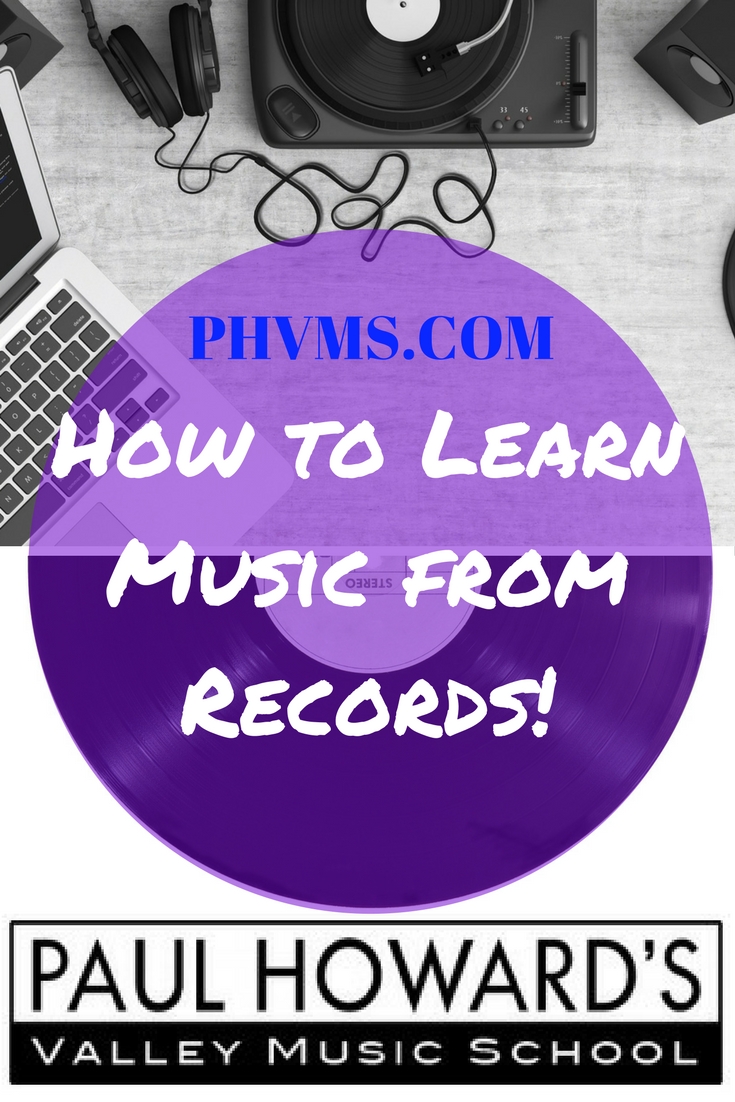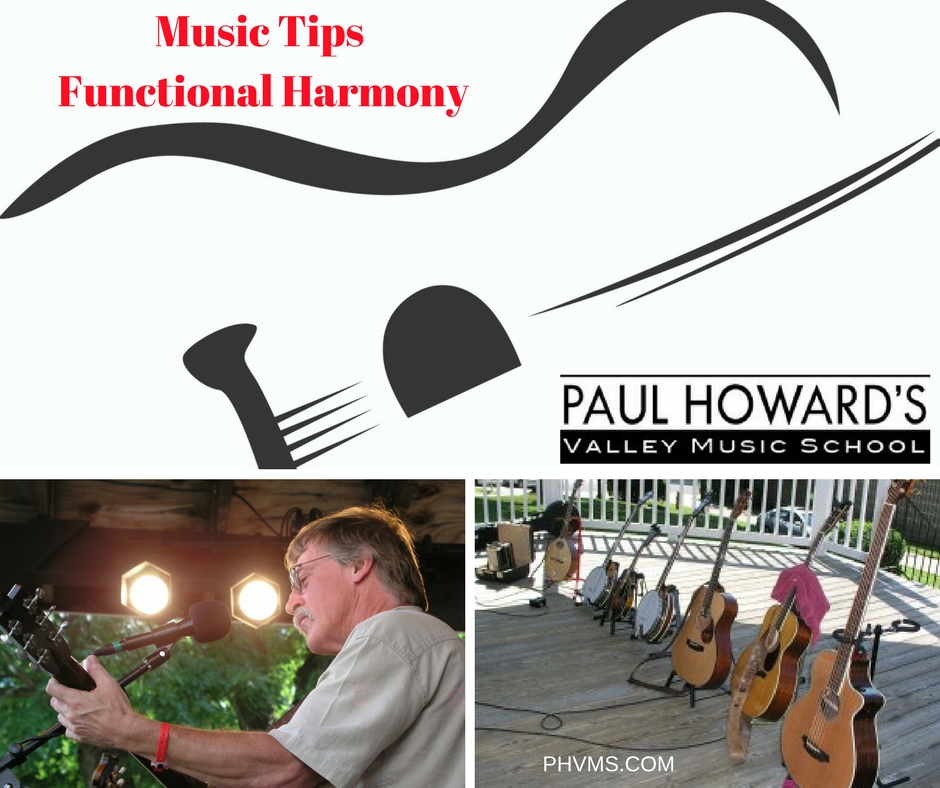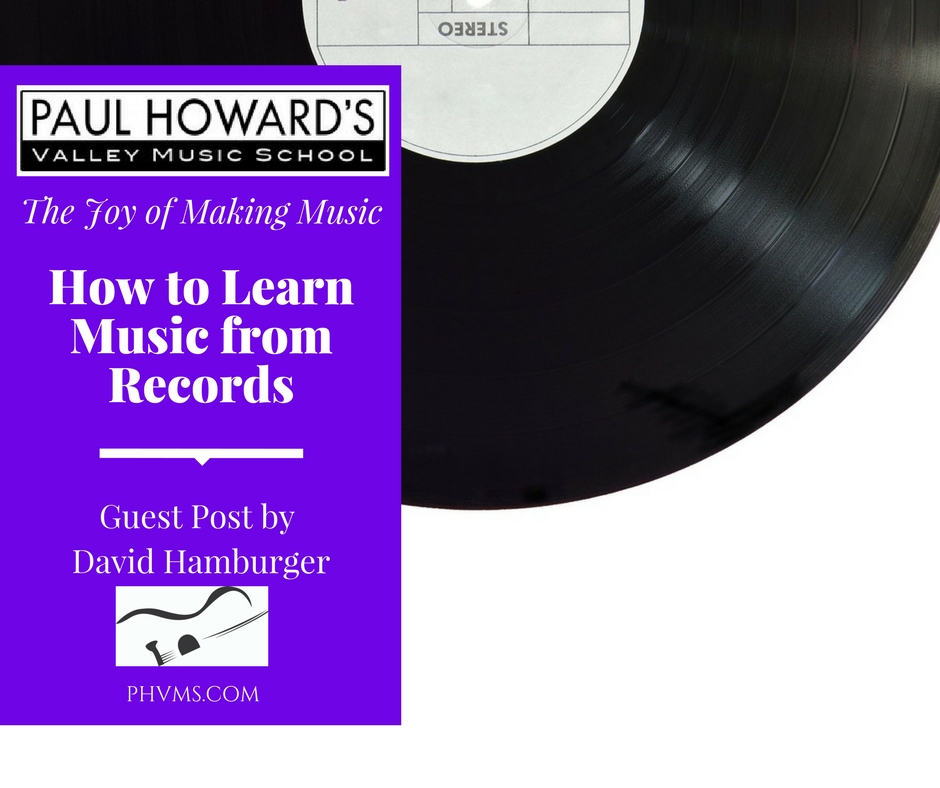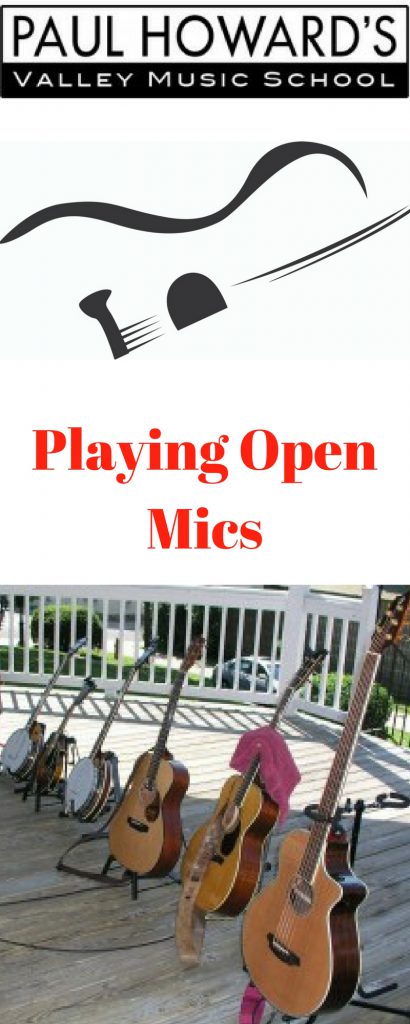
HOW TO LEARN FROM RECORDS
Guest post by David Hamburger
Ultimately, if you want to learn a style of music, it pays to go to the recordings themselves to see how it’s
done. It’s the closest thing we have to traveling back in time to see our favorite artists in their prime, and
it only takes a couple of choruses of Albert King to make the light bulbs go off about Eric Clapton, Stevie
Ray Vaughan and probably a whole lot of other folks too. But there’s so much out there to hear and it can
be hard to see how to get from listening to the greats to understanding what they’re doing. Here are five
suggestions for how to start, or improve, that journey.
1. Don’t Listen to Everything
Well, not exactly. Listen to all you can, but then pick some things you really, really like and spend some
time on just that. With what seems like the entire history of 20th-century music available to us now in a
click or two, it’s hard not to feel like you should listen to it all, or to skip from track to track without
really hearing what’s going on. When I was in my twenties, I got to spend an hour talking with Tal
Farlow over a sketchy cafeteria dinner. I had recently gotten into Columbia’s Charlie Christian reissue
Genius of the Electric Guitar , and I’d read in a Guitar Player interview that Farlow had learned to play in
part by figuring out Charlie Christian solos. So I asked him about it, and his answer, even in the
pre-internet era, was a revelation. “There’d be a new Benny Goodman Sextet 78 every six weeks or so,”
he told me. “And if there was a guitar solo on it, it might be eight or twelve bars long. So I would learn it.
And then, I would spend the next six weeks figuring out everything else I could do with it, until the next
record came out.”
I did a little quick math, and realized the LP I had at home would have represented over a year and half of
information to a young Tal Farlow. And that was just one of a couple dozen records in my burgeoning
jazz collection. Yet Tal Farlow had managed to become one of the giants of bebop guitar by making the
most he could of a fraction of the information I had. It made me realize two things. One, you can get a lot
of mileage out of a small amount of information, if it’s good information. And two, and maybe even more
importantly, as enthralled as we all are by learning other people’s licks as perfectly as we can, it doesn’t
really start to become something useful until we start to pull it apart, see what makes it tick, and figure out
how to put it back together again in more than one way.
So listen a lot, but do it in order to find the things you dig the most. And then, spend some real time with
the things you pick. If you really want to go deep, take a single record and imagine you have to review it.
Or take single song, or even a single solo, and imagine it’s all you can use to explain the blues to someone
who’s just landed from Mars. (Granted, I’m just assuming they don’t have the blues on Mars. Saturn,
maybe, according to Sun Ra. But not Mars. Although I could be wrong.)
2. Be a Big-Picture Listener
A lot of times, the thing that gets us as guitar players are the small moments: “Did you hear that lick?
That thing he does on the V chord?” Which is great, and a big part of zeroing in on the particulars, as
discussed above.
But you want to be sure and pull back, widen your view, and get a bigger picture of what’s going on.
Guitar playing takes place in a context, and for starters you have to be aware of the groove, the tempo,
and the genre (or sub-genre) of the song in question. That’s especially true when you’re the one actually
playing, so it’s a good idea to get used to noticing the surroundings even when you’re listening. Most of
us do this on some level regardless, but consciously appreciating those elements is a good habit to
cultivate. Some linguists trace the origin of the now-ubiquitous word “hip” to an earlier African word
indicating “one who has his eyes open.” Whether that etymology is bogus or not, it’s as good a state to
aim for as any, onstage or off. You want to be aware of what’s going on, so you can participate
appropriately with both alacrity and style. Put another way, if you get what’s going on, you can jump in
and do the right thing by the music at hand.
So if you’re fascinated by a particular lick in a tune, step back and notice how it fits into the
chorus of the solo it appears in. How is it arrived at, how is it departed from? And if that chorus is part of
a lengthier solo, how does that chorus fit into the overall scheme of the solo? How does the solo build,
and how does that chorus contribute to the build? And then, how does the solo fit into the song as a
whole? What’s going on just before the solo, what job does the solo have in the song? Is it a tasteful
restatement of the melody, the main point of the song, or somewhere in between? You want to arrive at
some idea of why things are happening, because that’s part of understanding the choices musicians make
as they solo. And that is something you need to begin arriving at yourself. If you feel like your solos
wander or run out of steam, maybe it’s because you don’t have enough of a reason for the things you play.
There’s playing to fill up space, and there’s playing to take the listener somewhere. And just like you can
learn the licks themselves, with a little deeper digging you can start to get a feeling for the way other
musicians manage to take you along with them – that elusive, telling-a-story business that everyone talks
about but no one seems able to explain.
3. Read About Music
This may seem a little indirect, and if you’re pressed to find time just to practice, may even seem a little
ridiculous. But reading up on the music you’re into helps in two ways. It provides a context for what
you’re listening to, and it can lead you to other music and other artists you might not have found out about
otherwise.
I love reading books about music, and have done so for as long as I’ve been playing, but since I do a lot of
my listening online these days, I basically look at Wikipedia as the world’s greatest extended collection of
liner notes. As I pull up and listen to things in Spotify (killing the music industry one track at a time, I
know), I’ll do a search for information on that song or artist as well, and get my background information
that way. You can find out when a song was recorded, who played on it, who wrote it, when it originally
came out – all the basic stuff you don’t just flip over an LP or CD to find out anymore. And reading up on
the artists themselves can turn you on to important recordings you might not know about, as well as
putting them in a sort of family tree of related artists, which in turn will give you other roots and branches
to explore.
Sometimes you’ll even gain some kind of amazing insight into how a musician thinks about what
they do that’s directly applicable to understanding how they play. The second book I ever wrote
was all about playing electric slide guitar (Hal Leonard went way out on a limb with the title,
publishing it as… Electric Slide Guitar ). I decided the book was going to have to include Ry
Cooder’s slide style, which until then I had basically considered a pretty elevated kind of voodoo
somewhere in between how the Beatles made Revolver and what they do to unleash the Ark
of the Covenant in Raiders of the Lost Ark . But then I remembered the Guitar Player cover story I’d read
multiple times as a kid, in which Cooder explained that he basically used open G tuning for rhythm
playing, and stuck to open D for all of his slide soloing. Aha – that certainly simplifies things, doesn’t it?
An interview, if it’s a good one, is basically somebody sitting down and spilling all the things that make
them tick. As such, it’s the next best thing to getting to ask them about it all yourself. (And the best thing
about being a music journalist, while I was doing it, was exactly that: having carte blanche to ask all the
nosy questions I wanted about how somebody else played the guitar. Who knew Tony Rice was a big
McCoy Tyner fan in high school?)
4. Start Small
I had one lesson with alto saxophonist Lee Konitz, when I was about 22 years old. I was in pretty far over
my head, but I did get one fabulous piece of advice from him that I could actually use. Well, two actually,
but one that’s relevant at the moment. I was asking him about transcribing, which of course he absolutely
recommended. “I can’t really hear what Charlie Parker’s doing,” I said. “So don’t start with Charlie
Parker,” was his reply. “Start with something you can hear. Start with Louis Armstrong.” In other words,
start with the guy with the big, broad singable eighth-note melodies, and work your way up to the guy
with the ripsnorting double-time licks at 230 beats per minute.
That’s obviously a jazz guy’s take, but the blues version would be similar. Before tackling those insane
Stevie Ray Vaughan slow-blues onslaughts, try and work out the melody to a couple of Freddie King
instrumentals, which, like Louis Armstrong’s solos, sound like songs. They have short, clear phrases with
identifiable beginnings, middles and endings, and some of those phrases even repeat, giving you more of
a chance to start hearing and playing along with what’s really going on.
I’ll go further: what I generally recommend, and tend to do myself, is to learn just a lick or a
phrase at a time. If you’re just starting out, I recommend not even starting with figuring out solos,
but figuring out fills, or those licks that get played in between vocals during a verse. Talk about a
clearly identifiable beginning, middle and end – the vocal line finishes, somebody plays a lick, the vocal
comes back in. You’ve got a specific, clearly delineated project in front of you that’s not too daunting in
scope – much less so than a whole chorus, nevermind a whole multi-chorus solo.
If you’re already working on playing the changes some, or want to, you may need slightly longer
examples to see how people make transitions from one chord or one line to the next. In that case I suggest
the approach I took putting together my Fifty Jazz Blues Licks video. In that situation, I looked at the
twelve-bar blues progression the way I usually do, as three line of four bars each. Then, I listened to
musicians playing over the kinds of grooves I like, looking for how they would play the first four bars of a
blues and resolve it to the IV chord in bar five. Or how they would play the last four bars of a blues to
hear how they played through the turnaround. That way, I developed a little collection of moves for each
line of the blues that was really specific: “Ah, here are some different ways to get from the I to the IV.”
“Here’s how people seem to handle the turnaround.” And I was only having to transcribe four or five bars
at a time, which is a nice, compact amount of music to digest.
5. Start Where You Are
Learning from recordings is a cumulative process; the more you try and do it, the better you’ll get. It also
contributes to your abilities as a musician: what could be more useful for sitting in or being a more
responsive band member than having the ability to hear music go by and quickly realize what’s going on
and what your role in it might be? That said, it can seem daunting to try and sit down and figure out
what’s happening on your favorite tracks. If that’s so, then start as broadly as possible. Can you figure out
what key the song is in? Can you match at least one or two of the chords as they go by? How about the
position the solo is being played in? Does it sound pentatonic, or like other, more elusive and colorful
things are going on as well? Just getting in the neighborhood with these basics is a good start.
If you’re already farther down the path and can figure out things from records, then it gets back to the Tal
Farlow principle: now that you can play that B.B. King lick, what can you do with it? And do you
understand what makes it tick, in the first place? Is it spelling out the changes, or not, is it similar to
anything else you know how to do, do you recognize it as coming out of a particular chord shape or scale
pattern you know?
There are also a few other tools out there now that didn’t exist in the stone age of my youth.
Slow-down software is all the rage and has been for some time; lots of people like the Amazing
Slow Downer, and I hear good things about Transcribe! made by a company called Seventh
String. And then there’s Youtube – not only is the world awash in reissues of the great twentieth
century roots musicians, you can usually find some kind of footage of them online as well. I read this
great story in a reissue box set of Elmore James recordings (liner notes!) in which Robbie Roberson
recounted, “I spent a few weeks trying to get that sound, till my fingers were bleeding. Finally, somebody
said to me, ‘You know, he plays with a slide.’” Luckily, that doesn’t have to be you. I don’t know if
there’s any footage of Elmore James online but there’s just about everybody else just a couple of clicks
away, and you can learn so much just from watching – are they in open position, do they use a capo, is it
one guitar or two doing that?
So find some recordings you like, spend some time with them, pick the things you dig the most and see if
you can get a handle on some part of them. Then start trying to figure out what else you can do with them,
and learn a little about where those recordings came from and where they led. It’s not the whole process,
but it’s a big part of it. Blues musicians have been learning this way since records first appeared, so when
you’re not busy drinking water that tastes just like cherry wine, getting you a mojo hand or dating women
who study evil all the time, try spending some focused time with the masters and see if it doesn’t have a
positive impact on your playing.▩
Guest post via David Hamberger.





One thought on “How to Learn Music From Records”
Great article! I scratched a whole lot of records learning to play guitar. I sure wish I had some lessons from Paul Howard back in the day! Better late than never! Thanks for teaching me the guitar, autoharp, drums, MANDOLIN (love it!) and now the piano! So many instruments to learn and so little time! Great school!
Comments are closed.